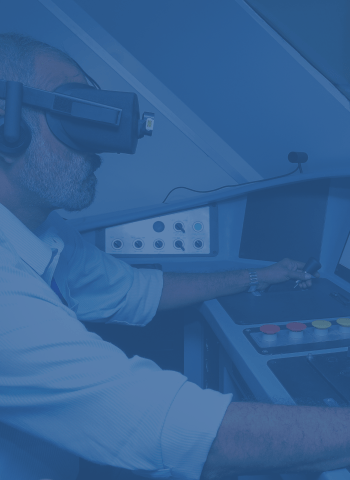About the customer
REDS SA is a consultancy company that improves railway safety and energy efficiency by increasing train operators’ skills in effective driving. They offer simulation tools that utilize custom rail controllers with detailed train simulation software that can be displayed from large TV screens to virtual reality headsets.
The challenge / Business requirements
REDS representatives asked us to develop a prototype of a professional train simulator for Virtual Reality headsets. Typical train simulators require a large TV screen or complex train cockpit with multiple screens installed. This classic setup is difficult to transport. They want to build something that could be easy to pack and move because they want to do workshops for their customers at their facilities and reduce the cost of installation. Virtual Reality technology seems to be ideal because it can replicate real train cockpit and simulate different scenarios and different weather conditions. Typically, train drivers are not familiar with immersive technologies, so we want our simulator to be simple and not cause nausea or tiredness. Simulation sessions usually take several minutes up to half an hour or even more as we want our users to travel very long routes (up to 35km long). Over those requirements, the application had to deliver realistic train physics and modify real-time scenario conditions like changing weather or time of the day.
The solution
We have used Unity to build a VR train simulator as it has the best performance compared to other game engines. We made hundreds of small scenes to represent a complex virtual world and used scene streaming technology to move around with high speed with a relatively low need for GPU resources. We had to create very optimized graphical assets for train cockpit and rail infrastructure to have all technical details as they real rail counterparts. It took a few months of hard work, but we could keep a very stable VR projection (never dropped below 90FPS and often kept 120FPS with a powerful laptop). The application was built for Oculus v1 headset. As it comes out during internal testing, the display has a too low resolution to display signal lights from a realistic distance (up to 2km in front of the train driver). Signal lights were smaller than one pixel and were not visible in VR. We had to make some LOD optimization and object scale tricks to make it bigger to be appropriately rendered and be visible with the range of 2 km in front of the driver. Weather effects and changing lights according to time of day were challenging for VR, but we found a golden spot that did not affect performance too much. We could make a smooth transition from a warm summer day to a snowy winter night by pressing one button. The final result was better than we expected. VR simulation performance was outstanding, and our test users never had nausea or fatigue.
VR Train Simulator for REDS
Technical engineer using IF Remote Vision.Train driver testing the Train18 simulator.

The partnership between supplier and customer
Our partnership with REDS SA was 1.5 years long, and during this time, we have created more than 50 km of the virtual world. Our simulator was publicly present during Hannover InnoTrans fair trade in 2019. We have received very positive feedback from our users, which convinced us that Virtual Reality could be beneficial in training and professional simulations.
